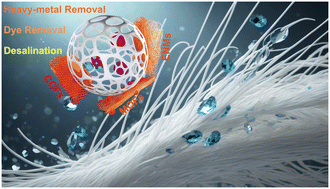Emerging trends in membrane-based wastewater treatment: electrospun nanofibers and reticular porous adsorbents as key components
Abstract
The increasing global population and its reliance on water-based activities have led to freshwater scarcity and unequal distribution. Researchers have responded to the pressing need for effective wastewater treatment by developing new adsorbent materials. However, practical application of these nanomaterials is hindered by challenges in scalability, regeneration, and agglomeration. The integration of nano-adsorbents into polymeric membranes, particularly electrospun nanofibrous membranes, holds potential for improving their performance, reusability, and durability, while also addressing separation concerns. This comprehensive review examines the selection and application of innovative adsorbent materials in membrane technology for wastewater treatment. It explores synthetic techniques for membrane fabrication, emphasizes the impact of materials like 2D materials, MOFs, and COFs, and also addresses problems such as biofouling. Additionally, this study highlights the potential of zwitterionic materials in mitigating biofouling and discusses the concept of biomineralization for water remineralization. Altogether, this review provides valuable insights into the current progress and prospects of material selection in membrane technology for water remediation.

- This article is part of the themed collection: Environmental Science: Water Research & Technology Recent Review Articles


 Please wait while we load your content...
Please wait while we load your content...